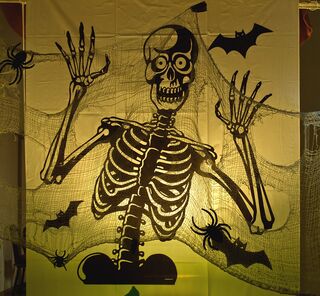Fear
Why Halloween Can Be Therapeutic
Halloween can allow people to face their fears with humor and fun
Posted October 24, 2020 Reviewed by Kaja Perina

The Halloween decorations in my neighborhood seem more extravagantly demonic than usual; it seems that people are embracing the upcoming holiday full-force. With all the high anxiety and sadness from this chaotic year 2020, with the hovering fear of COVID-19 and the uncertain election, and the need for families to cheer up their children at home, people may be channeling that tension more than ever into the wacky dark expressiveness of Halloween.
Halloween brings up mixed feelings for some people, although it is generally one of the most memorable and amusing holidays of the year for Americans. It is a strong outlet for people’s “id,” the impulsive pleasurable dark side of our personalities and human nature, but in a carefully conceived, socially sanctioned way. The themes of Halloween are certainly morbid and scary: everything from ghosts to vampires and monsters and gory bloody skeletons is fair game when decorating otherwise placid neighborhood homes. Horror movies stream online all October, and pop-up shops are bursting at the seams with cheap plastic forms of macabre merriment. Trick-or-treating is the child-friendly distilled essence of a holiday that ultimately helps humans cope with the omnipresence of death, and the fears and anxieties associated with death.
The holiday gives people permission to openly express and address their feelings and concerns about death and fear itself, in a usually playful manner. The more ghoulish and gory the sights, the more even otherwise buttoned-up folks clap their hands and admire them. The traditional Halloween costumes allow people to play act other identities, often with humorous, satirical, spooky, or sexy intent (although sometimes controversy, of course, has surrounded these choices with regard to cultural appropriation and more).
The effect of these activities is to break down conventional social mores and boundaries for a day, usually with entertaining results. Halloween parties and events, especially in cities, can be full of festive memories with strangers happily chatting or complimenting each others’ costumes and laughing at their ingenuity or absurdity. (Sadly this year, we need to keep social distancing and COVID precautions in mind.)
There is also an element of sublimation and fear exposure (which haunted houses basically de facto are); people playacting things that are dark and horrifying help to defang those horrors. It is a sort of festive roleplay where one can reenact frightening things on one’s own terms and in turn feel empowered and emboldened against those things. The ability to author and control your expression of fear can lead to a feeling of relative safety; you can reduce genuinely awful events to bacchanalian silliness and tongue-in-cheek dark humor.
The typical items displayed in Halloween decorations are those that often comprise classic specific phobias, such as spiders, bats, skulls, graveyards, and more. This year of course there are trendy themes related to COVID, with COVID-attacked skeletons pushing shopping carts filled with toilet paper and spraying disinfectant, and pumpkins wearing surgical masks.
Plenty of neurobiological evidence and research note that specific phobias can improve after extinction of the fear sensitization pathway that triggers our evolutionary fight-or-flight response systems. By swarming ourselves with cartoonish and exaggerated images of these phobia-triggering phenomena, we may all be participating in a form of mass fear extinction therapy.
Of course, not everyone can or should minimize the genuine impact of traumas from death, murder, and other terrible events, such as the over 200,000 people and climbing dead from the pandemic in the US. Sometimes Halloween can become perhaps too flippant and too dissociated from what it mocks. For example, I still personally cannot tolerate extremely gruesome or ultraviolent horror movies; genuine violence towards others is not something to be sanitized or condoned. Desensitization to the point of emotional numbing can be counterproductive to facing our traumas and fears as well.
But Halloween only lasts for a brief time, once a year, and in the right context, it can be a relatively safe and fun outlet for people to release and share what we all have in common…our ongoing struggle to survive against difficult situations, and our common vulnerability as human beings.
References
Garcia, R. Neurobiology of fear and specific phobias. Learn Mem. 2017 Sep; 24(9): 462–471
Craske MG et al. Maximizing Exposure Therapy: An Inhibitory Learning Approach. Behav Res Ther. 2014 Jul; 58: 10–23.


